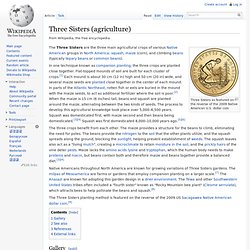

Are beards good for your health? Image copyright iStock If you were in search of a new, disease-fighting antibiotic, where might you start?

In a swamp? A remote island? Bezmaksas 'fotošops' autobusa pieturā. The Holographic Universe - 1 of 5 - Quantum Physics. Quantum Jumping - Communicate With Your Subconscious Mind. Sound Composition: Calm_Thunder_Storm. 15 Cats That Should Be Superheroes. Can you find the hidden animals in these 20 wildlife photos? As a wildlife photographer, Art Wolfe of course takes pictures of animals.

But not just any pictures. He finds and captures scenes that include animals so at home in their environment that you can hardly tell they’re there… Procatinator. Text Particles. The Useless Web. Three Sisters (agriculture) Three Sisters as featured on the reverse of the 2009 Native American U.S. dollar coin In one technique known as companion planting, the three crops are planted close together.

Flat-topped mounds of soil are built for each cluster of crops.[1] Each mound is about 30 cm (12 in) high and 50 cm (20 in) wide, and several maize seeds are planted close together in the center of each mound. In parts of the Atlantic Northeast, rotten fish or eels are buried in the mound with the maize seeds, to act as additional fertilizer where the soil is poor.[2] When the maize is 15 cm (6 inches) tall, beans and squash are planted around the maize, alternating between the two kinds of seeds. The process to develop this agricultural knowledge took place over 5,000–6,500 years. Squash was domesticated first, with maize second and then beans being domesticated.[3][4] Squash was first domesticated 8,000–10,000 years ago.[5][6]
Etiquette in Japan. The code of etiquette in Japan governs the expectations of social behavior in the country and is considered very important.

Like many social cultures, etiquette varies greatly depending on one's status relative to the person in question. Many books instruct readers on its minutiae. Bathing[edit] Bathing is an important part of the daily routine in Japan. Baths are for relaxing, and the body must be cleaned and scrubbed before entering the bathtub or furo. In homes with small tubs, each family member bathes one by one, in order of seniority, traditionally starting with the oldest male or the oldest person in the household (grandmother may bathe before the father of the house). Bathtubs are increasingly common in modern Japanese homes, but there are still many small and old apartments in cities that do not have bathtubs, so public bathhouses called sentō are common. 1901 image of a sentō Onsen (温泉) translate into an English word hot spring.
Bowing[edit] How to Create a Line Design: 9 steps (with pictures) Edit Article Edited by Mimi, Krystle, Sondra C, Elyne and 30 others We all know that a line segment, or a line, is straight, right?

What if somebody told you that you could make curves entirely out of straight lines? With line design (also known as "string art" and "curve stitching") you can arrange a series of straight lines in a systematic way so that they create the appearance of a smooth curve, forming what is called an "envelope" in mathematics. These curves are based on mathematical formulas and can result in many complex and intriguing curves. Ad Steps 1Make an angle. Ad Tips If you would like to arrange the angles in circle, this is a way to make sure the angles are all the same. Warnings Use a straight edge or else it will look sloppy.If you mess up, start all over, because if you don't, one line will be out of proportion.
Pareto principle. The Pareto Principle asserts that only a "vital few" peapods produce the majority of peas.

The Pareto principle (also known as the 80/20 rule, the law of the vital few, or the principle of factor sparsity)[1][2] states that, for many events, roughly 80% of the effects come from 20% of the causes.[3] Management consultant Joseph M. Why did men stop wearing high heels? For generations they have signified femininity and glamour - but a pair of high heels was once an essential accessory for men.

Beautiful, provocative, sexy - high heels may be all these things and more, but even their most ardent fans wouldn't claim they were practical. They're no good for hiking or driving. They get stuck in things. Women in heels are advised to stay off the grass - and also ice, cobbled streets and posh floors. Erudīcija un pupu mizas 20.04.2012 Diena. TED: Ideas worth spreading. Gabriella Psychic and Spiritual Medium- Free Reading. BBC Nature - Zebra stripes evolved to keep biting flies at bay.
9 February 2012Last updated at 04:59 By Victoria Gill Science reporter, BBC Nature The team placed the sticky model horses in a fly-infested field Why zebras evolved their characteristic black-and-white stripes has been the subject of decades of debate among scientists.
